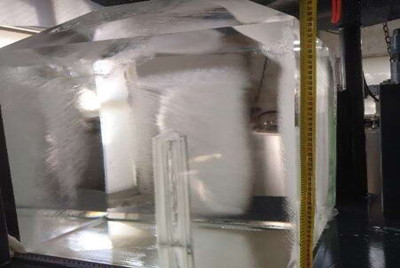
DKDP (KDxH2-xPO4), which can minimize stimulated Raman scattering, is the best nonlinear crystal used as a tripler in inertial confinement fusion (ICF) facilities.
It takes one to two years to get a DKDP tripler for ICF facilities using a traditional growth method. Therefore, the rapid growth method comes into being. However, in the 'point-seed' rapidly grown DKDP crystals, all prismatic faces and pyramidal faces grow under high supersaturated solutions, forming the so-called pyramid-prism (PY-PR) boundary which is detrimental to efficient frequency tripling and phase matching.
Recently, the researchers from Shanghai Institute of Optics and Fine Mechanics, Chinese Academy of Sciences (CAS), has successfully grown a large long-seed DKDP crystal with the size of 470 mm × 495 mm × 560 mm.
With a long seed of 320 mm high, the DKDP crystal has been growing for just over three months. And this crystal can cut out DKDP triplers that do not contain PY-PR boundary.
The long-seed DKDP crystal not only has the advantage of traditional method that does not contain PY-PR boundary, but also has the advantage of "point seed" rapid growth method that has a high growth rate. At the same time, it can also improve the cutting efficiency of triplers.
This is the first large long-seed DKDP crystal obtained in the world, indicating that the rapid growth of long-seed DKDP crystal has been successfully verified. And this is a new scheme of DKDP crystal growth method provided for the construction of ICF facilities.
The long-seed DKDP crystal is grown from a self-developed device quipped with a Continuous Filtration System in SIOM. The related crystal growth method and the self-developed device have been patented.

